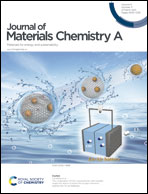Electrospun nanofiber fabric: an efficient, breathable and wearable moist-electric generator†
Abstract
Moist-electric generators (MEGs) that can directly harvest electricity from ubiquitous moisture are some of the most fascinating and promising candidates to supply renewable and clean power for next-generation portable electronics. However, the lack of necessary wearable properties such as air permeability and comfort, low voltage output and complicated fabrication processes of current MEGs have severely hindered their practical application. Herein, we for the first time demonstrate a breathable, flexible, deformable, large-area and easily fabricated electrospun nanofiber fabric as an efficient MEG. The maximum generated voltage reaches 0.83 V, outperforming all reported polymer based MEGs. Different from past research, two electricity generation mechanisms coexist in the electrospun nanofiber fabric due to the unique porous structure with numerous micro–nano scale channels. The electricity is not only extracted from ion diffusion driven by a concentration gradient, but is also induced by the streaming current of a liquid flowing along a charged surface in solid channels. Beyond power generation, the electrospun nanofiber fabric based wearable MEGs also demonstrate successful applications in self-powered respiratory monitoring, wind speed detection and touching detection. These findings offer new insight into the future design and development of innovative and truly wearable electronics.



 Please wait while we load your content...
Please wait while we load your content...